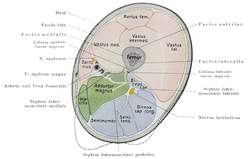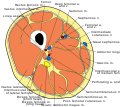Thigh
This article needs additional citations for verification. (April 2011) |
| Thigh | |
|---|---|
 A woman's thighs | |
 Cross-section of the thigh showing muscles and bone (latin terminology) | |
| Details | |
| Identifiers | |
| Latin | femur |
| MeSH | D013848 |
| TA98 | A01.1.00.035 |
| TA2 | 160 |
| FMA | 24967 |
| Anatomical terminology | |
In anatomy, the thigh is the area between the hip (pelvis) and the knee. Anatomically, it is part of the lower limb.[1]
The single
Structure
Bones
The
The femur is categorised as a
Muscular compartments
In cross-section, the thigh is divided up into three separate compartments, divided by fascia, each containing muscles. These compartments use the femur as an axis and are separated by tough connective tissue membranes (or septa). Each of these compartments has its own blood and nerve supply, and contains a different group of muscles.
- Medial fascial compartment of thigh, adductor
- Posterior fascial compartment of thigh, flexion, hamstring
- Anterior fascial compartment of thigh, extension
Anterior compartment muscles of the thigh include
Posterior compartment muscles of the thigh are the
Medial compartment muscles are
Because the major muscles of the thigh are the largest muscles of the body, resistance exercises (strength training) of them stimulate blood flow more than any other localized activity.[5]
Blood supply

The arterial supply is by the femoral artery and the obturator artery. The lymphatic drainage closely follows the arterial supply and drains to the lumbar lymphatic trunks on the corresponding side, which in turn drains to the cisterna chyli.
The deep venous system of the thigh consists of the
Clinical significance
Thigh weakness can result in a positive
Thigh injury
Society and culture
Western societies generally tolerate clothing that displays thighs, such as
Many
Strategic covering or display of thighs is used in popular fashion around the world, such as
Additional images
-
Front of thigh muscles from Gray's Anatomy of the human body from 1918.
-
Back thigh muscles of the gluteal and posterior femoral regions from Gray's Anatomy of the human body from 1918.
-
Also showing major blood vessels and nerves.
-
Cross-section through the middle of the thigh.
-
Theobturator externus
References
- ^ "thigh" at Dorland's Medical Dictionary[dead link]
- ^ "Thigh". Cambridge Dictionary. Retrieved 2021-06-23.
- ^ "Facts About Bones in Your Skeleton". Hospital for Special Surgery.
- ISBN 978-87-628-0307-7.
- ^ Cespedes, Andrea. "How Important Are Leg Workouts for Muscle Gain?".
- ISBN 9788131263617.
- ^ "Thigh". The Lecturio Medical Concept Library. Retrieved 2021-06-23.
- PMID 22203329.)
{{cite journal}}: CS1 maint: multiple names: authors list (link - ^ "Medically Sound: Field, Court, and Course Related Injuries – Sports Injuries". Medically Sound. 2020-08-31. Retrieved 2020-11-01.



